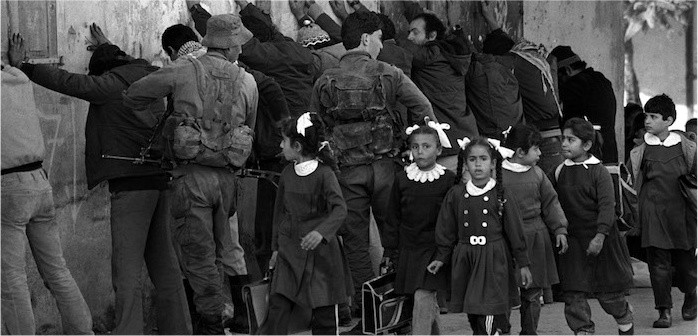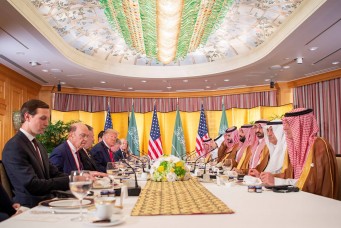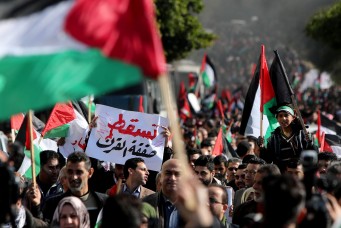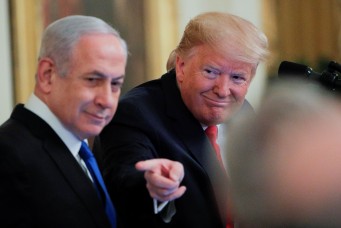A Century’s Legacy of Conflict
Understanding the lessons of a conflict deeply steeped in history is essential to resolving it. The strength of facts on the ground, the futility of “might makes right,” and the Palestinian-Israeli conflict’s persistent role in the region’s instability are all part of a legacy that must be acknowledged to achieve peace.

Palestinian schoolgirls pass Arab men getting frisked, Gaza Strip, Nov. 1986. Jim Hollander/Reuters
On November 2, it will be one hundred years since former British foreign secretary Arthur James Balfour sent Lord Walter Rothschild a letter asking him to convey to the Zionist Federation of Great Britain and Ireland his pledge to establish a “national homeland” for the Jews in Palestine. In fact, this pledge, known as the Balfour Declaration, is not the only promise the British made during the First World War concerning the region then known as the Near East (the term Middle East would come along later). They made many promises, among them the pledge to create a United Arab Kingdom in the Fertile Crescent. This commitment was made in 1915 in the form of the “Hussein-McMahon letters.” Then there were the promises London made to Paris over dividing spheres of influence in this region as was laid out in the Sykes-Picot agreement. The actual object of these pledges and commitments that Britain was distributing left and right was the legacy of the moribund Ottoman Empire, or the “Sick Man of Europe” as it was nicknamed at the time. London was divvying out Ottoman lands to the Jews, Arabs, French, Greeks, and others depending on how the “Great War” panned out.
The Balfour Declaration one hundred years ago, the Partition Resolution seventy years ago, and UN Security Council Resolution 242 fifty years ago each generated waves of conflict and peacemaking that the peoples of this region are still struggling with today. In 1917, British promises were contradictory and, indeed, conflicting. The Zionist lobby turned those promises into an immigration permit; the “national homeland” eventually became a “nation state.” They also turned a midget state, the borders of which were defined by UN General Assembly Resolution 181 on the partition of Palestine in 1947, into an empire that would seize and occupy the territories of three Arab states in addition to the whole of Palestine. This reality would appear in Resolution 242 of November 22, 1967 that established the ceasefire lines of the June war of that year.
The Balfour Declaration, with all its repercussions from resolutions 181 to 242 and beyond, started historical processes that no party has control over today. These processes have shaped a history that universities and research centers are still trying to understand and that poses such questions as whether it was inevitable that the parties involved had to endure all the sacrifices they made or whether there were other choices. In a letter sent from Gamal Abdel Nasser to President John F. Kennedy in 1961, the Egyptian president summarized Arab opinion of the conflict by describing the Balfour Declaration as being made from those who do not own, the British, to those who do not deserve, the Jews, without the consent of those who own and deserve, the Palestinians. It was the clearest narrative that formulated the existential nature of the conflict which left little room for compromise.
Lessons of History
As we look back at the history of the conflict, there are lessons to be learned. The first lesson is that the creation of realities on the ground has always proven to be stronger than legal or moral arguments. This helps identify a basic difference between the Jewish and Palestinian political elites. The difference does not just reside solely in the fact that Jews managed to appropriate and settle on land that had not been theirs, and on which Palestinians were already living, but also in their ability to build political, economic, and social institutions. In those days, the Jews faced major obstacles toward realizing the Zionist project, including the rise of Nazism and fascist movements in Europe, which were vehemently anti-Semitic. Those were also times when Jews were unwelcome as refugees or as residents in many countries. By contrast, the Palestinians, who had Arab kin and cultural extensions in the region and were living in their own country and on their own land, did little to build the kernel of a Palestinian state.
There were attempts, of course, but the difference in magnitude was great. Whether this was due to the British occupation of Palestine, the deeply rooted underdevelopment of the Arabs and Palestinians, or other factors, the result was that by the time of the partition resolution, the Jews were ready to run a state and to fight for its establishment. The Palestinians, for their part, were dependent on Arab countries, which had also suffered from colonial occupation and an array of problems of their own.
Lesson two is that military might, however strong, has limits. It cannot, in and of itself, achieve the objectives of any of the parties of the Arab-Israeli conflict. The Arabs failed in 1948 and 1967, but the Israelis failed in 1956 and 1973. Moreover, the Israelis failed to repress by force the first and second Palestinian intifadas that only subsided due to political and diplomatic efforts. Military victories sometimes proved to be counterproductive. In 1982, Israel achieved one of its greatest victories when it invaded Lebanon, and occupied an Arab capital, Beirut. The result of the war was the birth of the most resilient threat to Israel represented by Hezbollah, which has carried Iranian influence as far as the Mediterranean and Israel’s borders.
Regardless of its military victories, Israel has been unable to bring the Palestinian people to their knees and drive them out of Palestine. Some twelve million people are living in the area between the Jordan River and the Mediterranean. Half of them are Jewish Israelis, and the other half are Palestinians. They face each other down across the whole of Palestine and sometimes within a space as narrow as the Holy Mount that contains Al-Aqsa Mosque and the Wailing Wall. These demographic realities, plus the holy sites that embody history and religious passions, are also major realities on the ground. Despite the continuous victories of Israel from 1948 to 1967, and the military advantage it has always held over the Palestinian and Arab side, it suffered from a lack of legitimacy in the Arab World. With a multilayered conflict (state-to-state level, national liberation struggles, the popular revolt, revolutionary terrorism, conventional and guerilla warfare) no side has been able to win a decisive victory over the other.
The third lesson is that the Arab-Israeli conflict has a persistence and intrinsic impetus that has enabled it to keep going even as the whole world changes. The conflict began in the First World War, and survived the Second World War with its consequences for Jews, Arabs, and Palestinians, persisted through the Cold War with its vicissitudes and the collapse of the Soviet Union, and the upheavals that followed the attack against the World Trade Center in New York. Along the way the combatants had to adjust to changing realities and try to take advantage of new developments.
The futility of military might and the conflict’s persistence gives us lesson four: major shifts in the course of the conflict only occurred when there was direct dialogue between Arabs and Jews, and between the Arab states and Israel. Examples are to be found in the Camp David talks and the Egyptian-Israeli peace treaty that ended the Israeli occupation of Sinai in 1982, which was followed by a Jordanian-Israeli peace agreement in 1994. Between these two landmarks were the Oslo Accords that led to the establishment of the first Palestinian National Authority on Palestinian land, creating a Palestinian reality on the ground.
The fifth and last lesson is that the prolongation of the Arab-Israeli conflict has reduced the ability of Arab countries to meet developmental challenges, as well as confront strategic perils from within or from without the region. In the present decade, the anatomy of the Middle East has shown how far Arab-Israeli contradictions can bring marked challenges to both sides.
A look at the Middle Eastern contemporary experience brings six dimensions to the fore. The first dimension of the current chaos of the Middle East is the decline of unitary actors and the increased number of failed states. States like Syria and Iraq are fragmented and the number of failed states is even greater, including Yemen, South Sudan, North Sudan, Somalia, and Afghanistan.
The second dimension involves the number of different kinds of conflicts going on simultaneously. Some are primarily a struggle for power, the most salient of which is that between Saudi Arabia and Iran. Other conflicts are primarily about identity, whether ethnic or confessional. Clearly, the Shia-Sunni divide is tearing apart much of Iraq and Syria. Finally, there are conflicts over the control of natural resources, whether oil in northern Iraq and Libya or water between Egypt and Ethiopia.
The third dimension of the chaos concerns the many different types of actors battling one another. In some corners of the Middle East, the armed forces of external powers are employed against local forces. Such is the case when the air assets of the United States, Russia, Britain, and France bomb ISIS targets, real or imagined. In other corners, regular forces of Middle East states are fighting non-state actors like when the Jordanian air force was deployed against ISIS in Iraq, or when the UAE conducted air operations against jihadists in Libya, Syria and Iraq, or sent ground forces to fight in Yemen. In other battlegrounds in the Middle East the fight seems to be between the remnants of regular forces of a former state against ethnic, tribal, or confessional forces, as is the case with General Khalifa Haftar’s Libyan army units fighting against a multitude of tribal-based militias. Other battles are waged between different armed Jihadi forces such as Al-Qaeda-affiliated Al-Nusra Front fighting other units affiliated with ISIS in Syria. In some cases, ethnic-based forces fight Islamist organizations, as in the case of the Kurds battling ISIS in north-eastern Syria, and in others, tribal organizations fight Islamist organizations such as, in Iraq’s Anbar province, or when tribal-based militias fight one another as in Libya. With each of these fault lines having its unique characteristics, this multiplicity creates huge confusion and makes it very difficult to assess the “state of play” on the ground, and the real endgame for the parties.
A fourth dimension is the mutations we see in armed conflicts—the transformation of conflicts from one type to another. This takes place when non-state actors branch out across state borders as when ISIS has established a territorial base across the Iraqi-Syrian border thus transforming itself from an internal to a regional player. A similar phenomenon took place when an internal group pledged allegiance to a larger entity as when Beit Al-Maqdis in the Sinai Peninsula announced that it has joined ISIS. A third mutation took place when an internal or regional conflict was internationalized as when the United States began to fly sorties against ISIS targets in Syria and when Russia began to do the same against other opponents of the Bashar Al-Assad regime.
A fifth dimension of the chaos concerns the heightened complexity of the region’s economics. This new complexity is manifested in a number of aspects: first, the multitude of different economic entities—states, militias, terrorist organizations, and organized crime mafias. Second, semi-state economic entities now cross previously recognized national borders. Third, to wage their fights, sub-state actors no longer depend on external financing; instead they self-finance by trafficking and selling captured humans, natural resources like oil, and art and archeological artifacts. Finally and amazingly, many of the ungovernable parts of the Middle East have seen an increase in the price of basic commodities—especially food—while the price of drugs has dropped.
The sixth and final dimension of the recent developments in the Middle East concerns the heavy human costs sustained by the region’s states since the onset of the Arab Spring. The number of dead is estimated to have reached 430,000, the number of wounded to have reached 2.5 million and the number of displaced to have reached 14.3 million, among them some eleven million Syrians.
Arabs and Jews Share the Same Future
The one hundred years since the Balfour Declaration, the seventy years since the partition resolution, and the fifty years since the June war all tell the story of a historical tragedy; but this anniversary year should compel us to read the past again, with an eye fixed on the future, rather than to lament over the ruins of the past. The Arab Peace Initiative may be the key to determining how to arrange things in a region that has never experienced order unless some outside power imposed it, as was the case with Britain and its promises, and the United States and its troubled endeavors. After all, there is nothing to prevent us—the now-independent peoples of this region—from undertaking this task today.
Understanding the limits of power can be a first step forward. Israelis and Palestinians have to understand that a century of negative interactions did not leave them with any place else to go. They are in reality sharing the same land and probably the same destiny. In the New Yorker, Palestinian scholars Hussein Agha and Ahmad Samih Khalidi recently wrote that they see a “budding” direction toward “the increasingly blurred borders between Arabs and Jews in the territory. Israeli settlements may have all but erased the 1967 borders in one direction, but fifty years of occupation have helped to erase the border in the opposite direction as well.” Israeli-Palestinian interactions have gone far beyond their demographic and geographic necessities to include economic, religious, and security requirements. In reality, both peoples, Israelis and Palestinians, though divided, are living within one realm. The livelihood of each is dependent on the others’ strategic moves. The interdependence between the two sides should not be clouded by the pronouncements of hatred and antagonisms they express toward each other. In reality, Israeli and Palestinian territories are operating under one labor, trade, tax, and active currency market. Security interdependence is no less viable: the Palestinian security establishment that matured under Israeli, U.S., and European and Arab cooperation contributes toward Israeli security as well as Palestinian governance. Yossi Alpher wrote in an article for the Carnegie Endowment on the coming decade of Israeli-Palestinian relations: “By 2017, Israel and Palestine were slowly sliding down a slippery slope toward a single political entity.”
In 2002, I was invited to address the Moshe Dayan Center at Tel Aviv University in Israel. After my presentation, an audience member asked, when do you think the Arabs will stop hating Israelis? It took me a moment to overcome the shock of hearing this question. I finally gave an answer: the Arab hatred of Israel will stop when the Middle East region feels that it is better off with Israel in it than being without it. It is the job of the societies concerned to be involved in an honest process of self-examination that is free of blaming the other and scapegoating historical responsibilities.
This essay is adapted from a speech delivered at Brandeis University in Waltham, Massachusetts, on September 10, 2017.
Abdel Monem Said Aly is chairman of Al-Masry Al-Youm Publishing House and a senior fellow at the Crown Center for Middle East Studies at Brandeis University. He was chairman of Al-Ahram Newspaper and Publishing House between 2009 and 2011, and director of Al-Ahram Center for Political & Strategic Studies from 1994–2009. He is the author of State and Revolution in Egypt: The Paradox of Change and Politics, and co-author of Arabs and Israelis: Conflict and Peacemaking in the Middle East.





